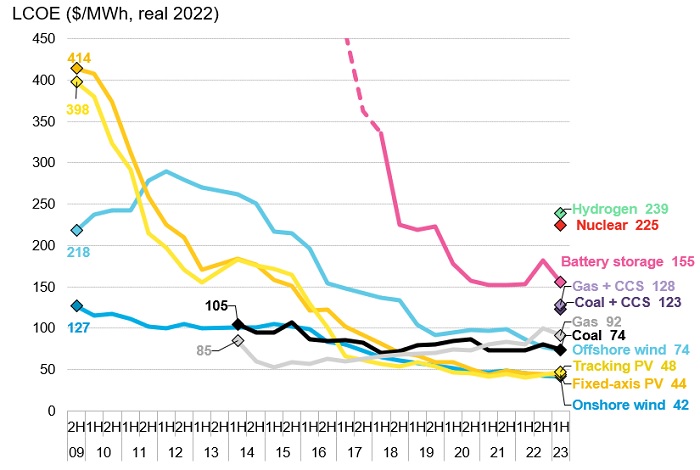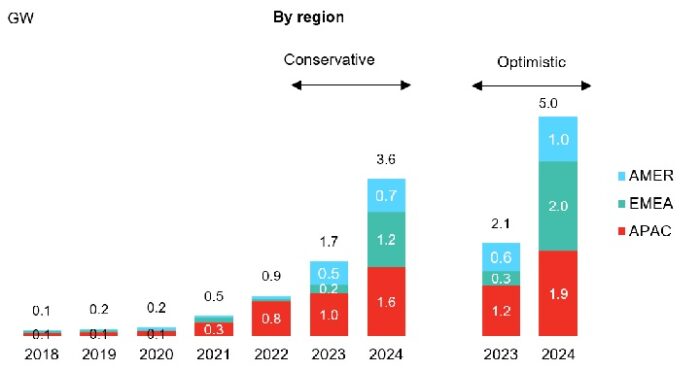Hydrogen, the most abundant element in the universe, holds tremendous potential as a clean and sustainable energy source. Its presence is ubiquitous, comprising about 70% of all matter in the cosmos1. However, while hydrogen’s abundance is awe-inspiring, tapping into its vast potential for everyday energy needs isn’t always straightforward. The challenges lie in unlocking hydrogen’s energy by converting it into a usable form and efficiently harnessing it for various applications.
This blog outlines the role of two key technologies, electrolysers and fuel cells, in making hydrogen a source of renewable energy.
Out with the grey
Before discussing the two technologies that form part of the solution, it is also important to understand the problem a little bit further. When people say not all hydrogen is created equal, they are referring to the fact that most of the hydrogen produced today comes from fossil fuels. According to the International Renewable Energy Agency, as of the end of 2021, almost 47% of global hydrogen production came from natural gas, 27% from coal, 22% from oil, and only around 4% from the electrolysis of water (more on this later). Hydrogen produced from fossil fuels is referred to as ‘grey hydrogen’ if the waste product of the process, carbon dioxide (CO2), is allowed to be released into the atmosphere.
When the CO2 from the process is captured and stored, a significantly better environmental outcome, the hydrogen is referred to as ‘blue’. The best form of hydrogen, however, is ‘green hydrogen’, which is made through the electrolysis of water, that is, passing a current of renewable energy through water to separate hydrogen from oxygen.
To grow hydrogen sustainably, the world needs to eliminate grey hydrogen and scale up green hydrogen.
Hydrogen electrolysers
A hydrogen electrolyser is a device that generates hydrogen gas (H2) through a process called electrolysis, utilising an electrical current to split water (H2O) into its constituent elements, hydrogen, and oxygen. If the electrolysis is powered by renewable energy sources, such as wind or solar power, the hydrogen produced is referred to as ‘green’.
Given green hydrogen’s symbiotic relationship with wind and solar, its production is often near wind or solar farms. In a recent blog post, in which we highlight some notable renewable energy mega projects around the world, we also list Denmark’s Energy Island where 600 giant wind turbines will be accompanied by an electrolysis plant.
Further innovations are also happening to allow electrolysers to use seawater, which is available in abundance close to offshore wind farms. This will reduce the need for freshwater to produce hydrogen.
Green hydrogen also serves as a valuable long-duration energy storage solution when placed near wind and solar farms. It complements short-term battery storage by converting surplus renewable energy into hydrogen, enabling extended energy storage, and reducing renewable energy intermittency, thereby enhancing the overall reliability and sustainability of the energy system.
Figure 1: Hydrogen electrolyser shipments expected to double in 2023 and again in 2024

Source: Bloomberg New Energy Finance (BNEF) H2 2023 Hydrogen Electrolyser Market Outlook, 28 Aug 2023. Regions shown are Europe, Middle East and Africa (EMEA), the Americas (AMER), and Asia Pacific (APAC). GW is gigawatts. Forecasts are not an indicator of future performance and any investments are subject to risks and uncertainties.
According to Bloomberg New Energy Finance (BNEF), global electrolyser shipments are expected to double in 2023, despite universal project delays, and then double again in 2024, even in a conservative scenario. This is because Europe and the US are beginning to catch up with China in terms of production capacity.
Once the hydrogen is produced, putting it to use in various applications requires another device.
Hydrogen fuel cells
A hydrogen fuel cell is an electrochemical device that converts the chemical energy stored in green hydrogen into electricity. Fuel cells can bring numerous benefits to the world of mobility. They have zero emissions, given their byproduct is water vapour. They also have high energy efficiency with an energy conversion rate of up to 60% compared to 30-40% for internal combustion engines2. This means that, while an internal combustion engine converts 30-40% of the fuel energy into movement (with the rest lost in heat and friction), a fuel cell can convert 60% of the energy stored in the fuel into movement. Higher energy efficiency means lower volume of fuel required to be stored in the tank of the car, truck, ship, or airplane running on hydrogen.
Fuel cells are also quite versatile. They can be utilised as backup power sources for providing a reliable and efficient means of generating electricity during power outages. When the grid fails, fuel cells can quickly kick in to supply electricity, ensuring uninterrupted operations in critical applications such as data centres, hospitals, and telecommunications facilities. They also have a long life and operate quietly.
The two technologies clearly have a lot going for them. So, what might be holding them back?
The challenge
High costs and limited infrastructure are currently the biggest hurdles in the adoption of green hydrogen. Figure 2 below shows the high levelised cost of electricity (LCOE) in $ per megawatt hour (MWh) for hydrogen (which compares lifetime costs of producing electricity from different sources). While wind, solar, and battery storage have seen remarkable cost reduction in recent years as the technologies have scaled up, hydrogen is yet to experience the same. With more investment, however, this could change.
Figure 2: The levelised cost of electricity from different sources

Source: Bloomberg New Energy Finance, 7 Jun 2023. PV is photovoltaic. CCS is carbon capture and storage. https://www.bnef.com/insights/31489. Historical performance is not an indication of future performance and any investments may go down in value.
While there is a long way to go for this investment to bear fruit, there are notable green shoots in terms of both policy support and industrial innovation. In July 2023, Nikola Corporation was awarded a $41.9 million grant by the state of California to establish six heavy-duty hydrogen refuelling stations across Southern California. California, which is taking a leading role in decarbonising transportation, is aiming for these strategically located stations to support zero-emission vehicle adoption, reduce carbon emissions, improve community health, and provide refuelling for approximately 80 to 100 trucks per station per day.
In the world of aviation, aircraft manufacturers Airbus, Embraer, and Fokker are aiming for commercial launch of hydrogen-powered aircraft by 2035. As of June 2023, at least 23 aircraft operators, mainly regional airlines, and aircraft lessors, have signed some form of agreement to purchase fuel cell aircraft or engines3.
In automobiles, 8 manufacturers are actively working on hydrogen fuel cells vehicles. The list includes automotive behemoths like Toyota, BMW, and Jaguar Land Rover4. As more infrastructure gets built, others may follow suit.
The way forward for investors
Investors who are excited about the growth prospects of hydrogen and recognise the present moment as a point of acceleration for the technology, may find it useful to consider hydrogen as one ingredient within the renewable energy mix. The advancement in hydrogen electrolysers and fuel cells is making the dream of hydrogen as a source of renewable energy possible.
Sources
1 Source Forbes, “This Is Where The 10 Most Common Elements In The Universe Come From”, May 2020.
2 Source US Department of Energy, 2023.
3 Source Bloomberg New Energy Finance, 16 June 2023.
4 Source Fastech 07 July 2023.
—
Originally Posted September 22, 2023 – Two technologies that enable renewable hydrogen energy
Disclosure: WisdomTree Europe
This material is prepared by WisdomTree and its affiliates and is not intended to be relied upon as a forecast, research or investment advice, and is not a recommendation, offer or solicitation to buy or sell any securities or to adopt any investment strategy. The opinions expressed are as of the date of production and may change as subsequent conditions vary. The information and opinions contained in this material are derived from proprietary and non-proprietary sources. As such, no warranty of accuracy or reliability is given and no responsibility arising in any other way for errors and omissions (including responsibility to any person by reason of negligence) is accepted by WisdomTree, nor any affiliate, nor any of their officers, employees or agents. Reliance upon information in this material is at the sole discretion of the reader. Past performance is not a reliable indicator of future performance.
Please click here for our full disclaimer.
Jurisdictions in the European Economic Area (“EEA”): This content has been provided by WisdomTree Ireland Limited, which is authorised and regulated by the Central Bank of Ireland.
Jurisdictions outside of the EEA: This content has been provided by WisdomTree UK Limited, which is authorised and regulated by the United Kingdom Financial Conduct Authority.
Disclosure: Interactive Brokers
Information posted on IBKR Campus that is provided by third-parties does NOT constitute a recommendation that you should contract for the services of that third party. Third-party participants who contribute to IBKR Campus are independent of Interactive Brokers and Interactive Brokers does not make any representations or warranties concerning the services offered, their past or future performance, or the accuracy of the information provided by the third party. Past performance is no guarantee of future results.
This material is from WisdomTree Europe and is being posted with its permission. The views expressed in this material are solely those of the author and/or WisdomTree Europe and Interactive Brokers is not endorsing or recommending any investment or trading discussed in the material. This material is not and should not be construed as an offer to buy or sell any security. It should not be construed as research or investment advice or a recommendation to buy, sell or hold any security or commodity. This material does not and is not intended to take into account the particular financial conditions, investment objectives or requirements of individual customers. Before acting on this material, you should consider whether it is suitable for your particular circumstances and, as necessary, seek professional advice.




















Join The Conversation
If you have a general question, it may already be covered in our FAQs. If you have an account-specific question or concern, please reach out to Client Services.